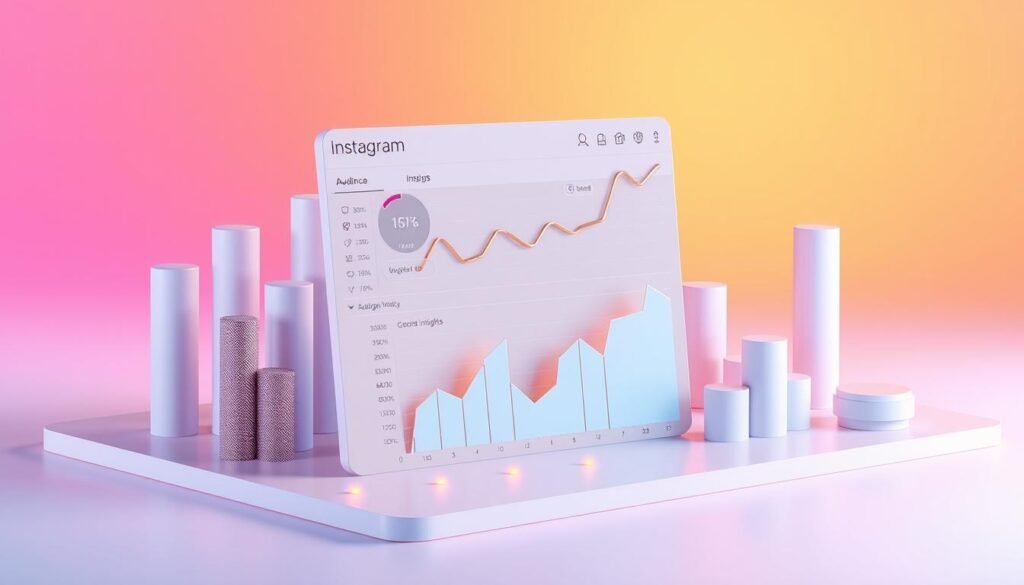Many Instagram users wonder: can you see who views your Instagram posts? There’s lots of interest in this. Sadly, the platform does not let you see who looks at your posts. You can see likes and comments, but not who views them.
Although you can’t see who views, you can see the number of views, likes, and comments. Be careful with third-party apps that claim to track viewers. These apps are not always safe. They may also risk your privacy. Check out this guide for more details.
Business accounts on Instagram do get detailed insights. These include shares, profile visits, and reach. But they don’t show who individually views your posts.
For strategies on using this info, visit Flock Social’s blog. They have a comprehensive guide and tips.
Understanding Instagram’s Privacy Settings
Instagram has public and private account settings. Each option affects who can see your content and your account’s visibility. Public accounts let everyone view your posts and stories. Private accounts limit views to only followers you approve. This choice is important for your experience and privacy on Instagram.
Public vs. Private Accounts
Public accounts are great for those seeking exposure. Anyone can see your posts, comment on them, and send messages. This choice is popular with businesses, influencers, and anyone wanting to be seen by many. But this means it’s harder to control who sees what you share.
Private accounts, on the other hand, give more control. Only approved followers can see your posts and stories. They are better for users who value privacy. You know exactly who views your content. This brings a sense of security.
Visibility of Posts and Stories
Choosing between public and private affects your post and story visibility. Public accounts mean anyone on Instagram might find your content. This can increase your engagement and reach. If you go private, only your followers see your posts and stories. Instagram lets all users see who viewed their stories, no matter the account type.
It’s smart to review your Instagram privacy settings often. This ensures your privacy level stays as you want it. While the app doesn’t show who looks at your profile, it does tell you who sees your stories and likes your posts. Stay updated and secure online.
How to Check Who Viewed Your Instagram Stories
Want to know who’s looking at your Instagram Stories? We’ve got your back! It’s easy to find out who sees your Stories. It just takes a few quick steps.
Steps to See Viewers
To discover who’s been viewing your Instagram stories, just follow these easy steps:
- Open Instagram and tap on your profile icon at the top left of the feed.
- Select the story you want to check.
- Swipe up on the story. You’ll see a list of names of people who viewed it. You can also see up to three of their profile photos.
You can only check who saw your story in the 24 hours after you post it. This info helps you see who interacts most with what you share.
Limitations on View Counts
Instagram does let you see who looked at your story, but only for a little while. After 24 hours, you can’t see their names, just how many watched. But, this total stays in your Archive one more day. Also, it doesn’t show if someone watched without you knowing.
This information helps you measure how much people interact with your stories. But it’s not the whole story. Knowing who checks out your IG profile is key to improving your Instagram game! 🌟
Can You See Who Views Your Instagram Videos?
Instagram sets clear rules about who can see video views. For Instagram Stories, you can see who checks them out. But for video posts, it’s different. Instagram shows how many viewed and liked the posts. Yet, it doesn’t share who exactly watched them.
Viewing Stats for Video Posts
After posting a video on Instagram, you see views under it. You also see some names who liked it. This helps creators understand who engages with their content. But, Instagram does not share who viewed your videos, keeping user privacy in mind.
Differences Between Posts and Stories
Instagram treats video posts and Stories differently. With Stories, you can see who viewed them. But video posts only show total views and likes, without names. This balance keeps user engagement up while respecting privacy. Instagram lets creators measure video success through views and likes, without sharing every viewer’s identity.
Want growth on Instagram?
We have the services for you!
Using Likes and Comments to Gauge Viewership
Instagram might not tell us directly who sees our posts. But we can use likes and comments to get a feel for interest and interaction. Let’s see how we can understand our audience better through these signals.
Identifying Viewers Through Engagement
When users like or comment, it shows they’ve seen and liked your stuff. Recognizing these people helps us know who often checks out our IG. These clues are key to seeing how far and well our content reaches.
Analyzing who consistently engages with your posts helps to identify your most loyal viewers. Their ongoing interest can guide your content strategy, ensuring that you continue to meet their expectations and maintain high engagement levels.
Analyzing Engagement Metrics
Metrics like likes, comments, and shares are vital for understanding Instagram interaction. They let us guess how much people interact with what we post. By watching these numbers, we can tweak what we do to match what our audience likes.
- Monitor the number of likes and comments to identify popular posts.
- Track the frequency and consistency of user engagement.
- Evaluate the types of content that prompt the most interaction.
By keeping a close eye on how people engage with our posts, we make our content better and more relevant. Every like and comment comes from someone who cares about what we do. Grasping these interactions helps us polish our strategy, pushing us toward more success on Instagram.
Are Third-Party Apps Reliable for Tracking Views?
Many third-party apps like Wrapped for Instagram say they can show who looks at your profile and posts. They are very popular. Wrapped has millions of downloads and is top-rated on the iOS App Store. But, it’s important to be careful with these apps. Meta, Instagram’s parent company, warns that these apps might break its rules. They say Wrapped’s data is not right or officially supported. This claim is supported by the app’s poor one-star reviews.
Meta asked Apple to take down Wrapped from the App Store. This is because it breaks rules and the data it gives is not correct. Instagram does not let you see who views your profiles or posts. This is true except for some basic numbers for business accounts. So, any app that says it can track Instagram viewers is not approved. These apps could also be dangerous for your privacy.
“Users have reported that data from these third-party apps seem off-target or inaccurate. Some speculate that the apps are randomizing results, showing top friends on Instagram that users haven’t interacted with,” said Meta.
Security and privacy should come first when using third-party apps. Some may claim to be “reliable Instagram apps,” but their data is often not true. These apps can also put you at risk. A better choice is to use Instagram Insights. This feature is for business and creator accounts and gives good data. It does not risk your privacy.
No third-party Instagram viewer tracker can give correct data on who views your profile. This is because of Instagram’s rules. By sticking to official tools and being careful with other apps, you can protect your account and personal info.
Understanding Instagram Analytics for Business Accounts
Instagram Business Accounts are key for brands that want to up their game. They let you peek into important data. This means you can better engage and find your audience.

Insights Available for Business Users
Those with Business accounts get to see a lot of useful numbers. These include:
- Impressions: How often your content was seen.
- Reach: The count of unique viewers.
- Engagement Rate: The percentage of viewers who interact.
- Follower Growth: Your daily follower increase or decrease.
- Demographics: Info on your followers, like age and location.
About 80% of Instagram users follow a business. This makes understanding these numbers super important.
Tracking Performance and Reach
Instagram makes it easy to track how you’re doing. You can see how many unique viewers you have. Plus, you can track traffic, including clicks to your website or Bio link.
“Reach is defined as the unique number of people who saw your post, Reel, or Instagram Story.”
Analyzing this data helps businesses change and improve. Tools like Brandwatch provide even deeper insights.
Getting these metrics right can greatly improve your social media strategy. It helps you connect with your audience and meet your goals.
Conclusion
Instagram finds a good balance between keeping user privacy and sparking interest. It doesn’t show who looks at your profile or videos. But it offers story views and account insights for a safe yet insightful experience.
Having a professional or creator account gives you more info, like how many people save your posts. This info can improve your engagement. It tells the algorithm your content is worth showing more, which might get you on the Explore page.
For businesses and influencers, more saves mean better visibility in follower feeds. This could lead to more interactions and followers. It’s a big plus for growing your presence on Instagram.
Some apps claim they can show who views your profile, but be careful. They’re not always right, and they could be risky. Instagram’s own tools are the safest bet for understanding your followers. Using what Instagram offers helps you connect better with your audience and boost your strategy. You can’t see who visits your profile, but Instagram’s metrics still offer valuable insights.




buy instagram comments in Cripple Creek